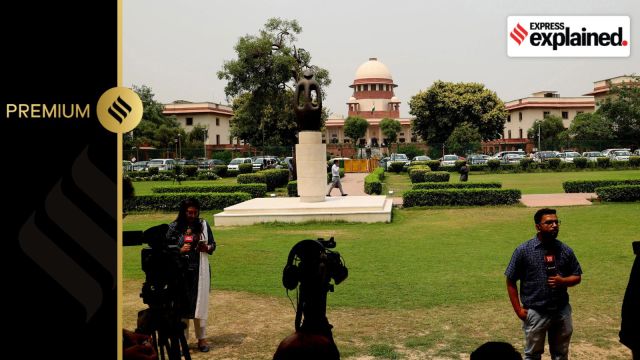A Bench of the five senior-most Supreme Court judges headed by Chief Justice of India (CJI) D Y Chandrachud “expressed serious concern” about comments made by a Karnataka High Court Justice V Srishananda earlier this month.

Since the judge tendered an apology, the SC dropped its intervention. But even a mild reproach by the apex court against a judge of a constitutional court is rare, and sends a strong message. The situation also highlights the constitutional limitations on how the judiciary can discipline judges.
Impeachment or nothing
Judges of constitutional courts enjoy a great degree of protection to ensure that they can exercise their powers without fear of interference from the executive. However, this also poses a difficult question: who will watch the watchdog?
As per the Constitution, impeachment, which is a political process, is the only recourse to dealing with errant judges. According to Article 124(4), a judge of the Supreme Court (or any High Court) can be removed from office only “by an order of the President passed after an address by each House of Parliament supported by a majority of the total membership of that House and by a majority of not less than two-third of the members of the House present and voting has been presented to the President in the same session for such removal on the ground of proved misbehaviour or incapacity”.
“Proven misbehaviour” or “incapacity” are the only two grounds for removal of a judge of the constitutional court. This, along with the level of political consensus required to pass an impeachment motion, makes the standard for impeachment very high.
Impeachment proceedings have been triggered only five times in history — against Justice V Ramaswami (SC, 1993), Justice Soumitra Sen (Calcutta High Court, 2011), Justice J B Pardiwala (Gujarat High Court, 2015), Justice C V Nagarjuna (High Court of Andhra Pradesh and Telangana, 2017), and then CJI Justice Dipak Misra (2018). The proceedings, however, have never been successful, although Justice Sen was impeached by Rajya Sabha and subsequently resigned.
Story continues below this ad
Several actions might fall short of the standard for impeachment, or become difficult to prove or generate political consensus on — indiscipline, petty corruption, instances of bias, or like in the case of Justice Srishananda, questionable conduct in court. Given that the alternative to impeachment under current laws is to simply look the other way, over the years the SC has developed alternative ways of discipling judges.
Judicial intervention
The first is through action on the judicial side, as in the current case.
In 2017, a five-judge Bench of the SC headed by then CJI Jagdish Khehar held Calcutta High Court’s C S Karnan guilty of contempt of court, and sentenced him to six months’ imprisonment. This was in response to some of Karnan’s actions as a judge in the Madras High Court, including the “sentencing” of SC judges to imprisonment, and accusing members of the judiciary of nepotism, casteism, and corruption. His transfer to the Calcutta HC in 2016 also took place in this context.
Karnan retired less than a month after the SC verdict, and was taken into custody to serve his sentence. But this set an uneasy precedent, with many voicing concern about one constitutional court taking to task judges of another. While district courts are under the supervisory jurisdiction of the respective High Courts, the relationship between High Courts and the SC is different.
Story continues below this ad
Veteran lawyer K K Venugopal had urged the apex court to ignore the judge’s comments, and let him retire with dignity. Senior Advocate Indira Jaising had argued that transferring the judge, or holding him guilty of contempt is no alternative to notifying him for impeachment.
As the court of last resort, the SC’s word is final and binding. This means that through judicial action, it can send a message to errant judges, even if such a power is not defined in the letter of the law.
Transfer policy
Another way in which the SC exercises influence over High Court judges is through the Collegium. The SC Collegium, comprising five senior-most judges of the apex court including the CJI, recommends the transfer of High Court judges.Given that the decisions of the Collegium are opaque, this transfer policy can be deployed as a tool to discipline judges as well.
The 2010 case of Justice P D Dinakaran is often cited as an example of the transfer policy being deployed to deal with judicial corruption. Even as proceedings for his removal as a judge were pending before a parliamentary panel, the then Karnataka High Court judge was transferred to the Sikkim High Court. Dinakaran was facing allegations of land grabbing and corruption. The move was criticised as only “transferring corruption” rather than dealing with it. Eventually, Justice Dinakaran resigned in 2011.








































